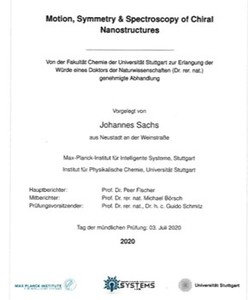Motion, Symmetry & Spectroscopy of Chiral Nanostructures
2020
Ph.D. Thesis
pf
Nanostructures are of interest for a broad spectrum of potential applications. For biomedical tasks, small nanoswimmers could help realize targeted drug delivery or minimally invasive surgery, which necessitates a comprehensive understanding and control of their motion. As an optical sensor, single plasmonic nanostructures can enhance the weak optical signals associated with biologically-important handed (chiral) molecules, and thus potentially lead to much higher detection sensitivities and improved selectivities. Both, the motion and spectroscopic behavior of nanostructures is closely related to the symmetry they possess. For propulsion at small scales it is well known that symmetry is important. For instance, the bacterial flagellum has a chiral corkscrew shape to allow non-reciprocal motion. One can therefore wonder if chirality is essential, and if indeed this is the simplest shape for propulsion, or if other structures – possibly ones that are simpler to fabricate – can also show propulsion when they are rotated. Another aspect that relates to the symmetry is the spectroscopic observation of nanostructures. Especially in chiral structures both the shape itself as well as the orientation in space determines optical signals. It is therefore important to be able to dis-entangle these effects. To shed light on this, this thesis presents experiments that capture the active motion and chiroptical spectroscopy of artificial nanostructures at low Reynolds number (Re), and examines the role chirality plays in these phenomena. Against previous expectations and reports, it is shown that a propeller does not need to be chiral to locomote and the first truly achiral propeller at low Re is reported. Similarly, a careful examination of the spectroscopy of plasmonic nanostructures shows that structures do not need to be chiral to give rise to chiroptical signals. A novel spectrometer was constructed to observe individual nanostructures. Thereby it has been possible to identify an observable, which has not been measured previously – that permits the true chiroptical spectrum to be obtained from a single nanoparticle suspended in solution. The basis for the presented experiments is the fabrication of micro- and nanostructures with simple and complex, achiral and chiral shapes via Glancing Angle Deposition (GLAD). The first part of this thesis considers active motion exhibited by highly symmetric micro- and nanoswimmers. Owing to the scallop theorem, reciprocal motion does not lead to a net translation at low Re, and other swimming strategies must be exploited, e.g. rotation-translation coupling. Previously, chirality was assumed to be required to efficiently couple rotation to translation at low Re, as is demonstrated by the corkscrew-shaped bacterial flagellum. However, a symmetry analysis suggested that much simpler shapes are potentially also propulsive if they are rotated in a non-trivial way. This would have important implications as then a novel class of micro- and nanoswimmers with highly symmetric, and easier to fabricate shapes, become feasible. Here, the propulsion characteristics of V-shaped objects that are driven by means of an external torque are investigated. The torque was either exerted by an external magnetic or an electric field and the ”V”-shaped particle had a corresponding dipole moment. Experiments with macroscopic as well as microscopic rigid bodies revealed that the orientation of the dipole with respect to the body plays a crucial role for their ability to convert a rotation into a translation. Symmetry arguments are developed, which accurately predict whether or not the object is propulsive at all, and additionally if it moves uni- or bi-directionally. It is thereby unequivocally shown by theory and experimental evidence that chirality is not a prerequisite for efficient rotation-translation coupling at low Re but that propulsive objects are necessarily chiral if they are driven magnetically. Surprisingly, rotation of a truly achiral object will also lead to a propulsion, which is experimentally demonstrated for the first time utilizing an electrically driven ”V”-shaped particle. Because chirality, i.e. Pb-odd symmetry, is not a requirement, an extended analysis that also includes the object’s symmetry under charge conjugation (CÒ) is employed to explain and predict the correct propulsion characteristics of arbitrary shaped objects by means of rotation-translation coupling. In contrast, spherical objects are unable to utilize rotation-translation coupling. However, beads with unequal chemical reactivities on the two ”faces” of their spherical body, so called Janus particles, can show enhanced diffusion if a suitable chemical substrate is provided. A catalytic reaction converts the intrinsic asymmetry of the particles into a pressure gradient, which leads to a self-generated motion. Most reports of self-propulsion to date concern larger microparticles. In this thesis, it is examined if this means of propulsion can also be realized in sub-micron sized Janus particles. The exact propul-sion characteristics are not fully clear in most chemically-driven particles and how their enhanced diffusion scales with size. Because of their small size the observation of individual particles is not possible and thus high density particle ensembles are observed by light scattering techniques, i.e. Dynamic Light Scattering (DLS), Differential Dynamic Microscopy (DDM) and Super-Heterodyne Laser Doppler Velocimetry (SH-LDV). In contrast to DLS and DDM, SH-LDV is identified as a versatile and suitable technique for the characterisation of active motion exhibited by Janus nanoparticles. First results on their size-dependent enhanced diffusion are presented, which show that this form of symmetry-breaking is effective at the smallest of scales. The second part of this thesis considers the spectroscopic response exhibited by chiral and achiral shaped nanoparticles measured in a novel single-particle spectrometer. It is based on dark-field microscopy and contains a balanced detection setup, which was built to record the Circular Differential Scattering Intensity (CDSI) of a single nanoparticle, i.e. the difference in scattering intensities for left- and right-circularly polarized light. This is known as chiroptical spectroscopy and typical setups are limited to the examination of stationary single particles. However, problems arise as their spectra appear distorted owing to a fixed light-object symmetry as well as interactions with the surface to which the particles are adhere. In contrast, the approach employed in this thesis opens up the possibility to record chiroptical spectra in ”one shot” and hence observe single mobile nanoparticles away from a surface. Crucially, a freely suspended particle in a liquid randomly reorients due to Brownian motion, which leads to an isotropic sampling of all spatial orientations. Based on this principle, this work presents time-resolved spectroscopic observations that yield snapshots for a particular alignment during the re-orientation of the particle, and the average of the time-series of snapshots provides a true chiroptical spectrum of a single nanoparticle in bulk solution away from a surface. Remarkably, this is the first time that the chiroptical spectrum of a freely diffusing nanoparticle has been observed. Experiments confirm that the novel approach detects intrinsic chirality of a single nanoparticle and additionally it is shown how even achiral particles can exhibit apparent chirality for stationary orientations. A magnetic and plasmonic nanohelix, whose alignment is controlled in an external magnetic field validates the crucial dependence of the chiroptical spectra on the light-object symmetry. Finally, the ergodicity of this chiroptical spectroscopy is demonstrated by showing the equality between time-averaged single-particle and traditional ensemble-averaged spectra. This has important consequences as now the same information de-duced by typical measurements conducted on many particles in a cuvette is recovered by utilizing only one nanoparticle. The results presented herein show that the single-particle spectrometer is a promising platform for novel sensing applications.
| Author(s): | Sachs, Johannes |
| Year: | 2020 |
| Month: | July |
| Day: | 3 |
| Department(s): | Micro, Nano, and Molecular Systems |
| Bibtex Type: | Ph.D. Thesis (phdthesis) |
| Address: | Stuttgart (und Springer, Cham) |
| School: | Universität Stuttgart |
| Degree Type: | PhD |
| DOI: | 10.1007/978-3-030-88689-9 |
| ISBN: | 978-3-030-88688-2 |
| State: | Published |
| URL: | https://stg.ibs-bw.de/aDISWeb/app;jsessionid=446B34EC6C1303935A62E07C0FD4434D |
|
BibTex @phdthesis{2020SachsPhD,
title = {Motion, Symmetry & Spectroscopy of Chiral Nanostructures},
author = {Sachs, Johannes},
school = {Universität Stuttgart},
address = {Stuttgart (und Springer, Cham)},
month = jul,
year = {2020},
doi = {10.1007/978-3-030-88689-9},
url = {https://stg.ibs-bw.de/aDISWeb/app;jsessionid=446B34EC6C1303935A62E07C0FD4434D},
month_numeric = {7}
}
|
|


